
Now the Lord God had planted a garden
in the east, in Eden...
Genesis 2:8
Approximately 120 different kinds of plants are mentioned in the Bible and can be identified with some certainty. Our Biblical Garden contains about sixty different species.
Naturally, a garden is a living being. Plants grow, flower, wilt, and die. Some plants need to be sown every year. Others are visible only part of the year, flowering in spring or in fall and seemingly disappearing for the remainder of the year.
The months of June through September are the best time for visiting our garden because during this time most plants can be seen.
THE CREATION
1 Pomegranate
A delicious fruit full of juicy red seeds.
Was this the one that tempted Adam and Eve?
In the Song of Songs (4:3) the poet speaks of the pomegranate as a symbol of beauty and fertility.
2 Fig Tree
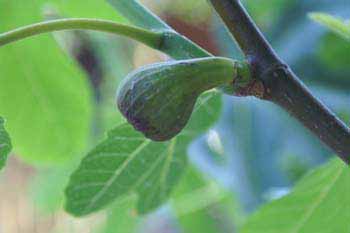
For people in biblical times, the fig was an important part of their diet.
The fruits can be eaten either fresh or dried.
A little wasp is needed for pollination.
Adam and Eve made clothes for themselves from the big leaves of the fig tree, as the story goes.
((Genesis 3:6-7))
3 Milk Thistle
4 Globe Thistle
The ground will produce thorns and thistles, and through painful toil will man eat of it all the days of his life ((Gen. 3:18)).
Slender as these plants grow, it might well have been these that Gideon used as a whip ((Judges 8:7.16).
5 Oleander
In the apocryphal 4th book of Ezra (9:26) the word "Ardat" is mentioned as the name of a town. This word is related to the Hebrew term for Oleander.
This beautifully flowering but poisonous plant grows along riverbeds.
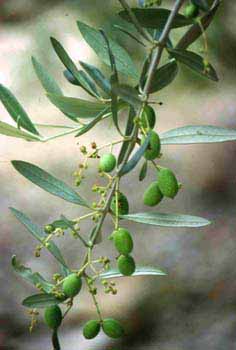 6 Olive Tree
6 Olive Tree
The olive is one of the earliest plants to be cultivated in the Mediterranean region.
Olive oil was used for daily nourishment, for anointing, and for lighting of lamps, depending on its quality.
An olive leaf brought by the dove signaled to Noah that the water had receded from the earth (Gen. 8:11).
7 Bay Laurel
It is not quite clear if Isaiah 44:14 really means the laurel, but this fragrant tree is a common sight on Mount Carmel which is renowned for its beauty.
The apostle Paul obviously was familiar with the Greek custom of giving a wreath of laurels as a prize to the fastest runner at athletic games. ((1 Cor. 9:25)).
8 Citron
Native to India, most citrus species came to the Mediterranean Basin later than during biblical times. Possibly an archaic citrus species, the citron, reached Israel by the people returning from the Babylonian captivity.
The "fruit from beautiful trees" (Lev. 23:40) which are supposed to be used at Sukkot are commonly interpreted to be the citron, and the etrog citron is used for this Jewish holiday.
The fruits of the citron are very large with an extremely thick peel and very little juice. The peel is used for making candied fruit.
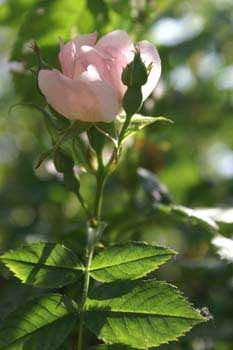 WILD PLANTS AND FLOWERS
WILD PLANTS AND FLOWERS
9 Phoenician Rose
10 Dog Rose
Very likely the Mediterranean Basin was the origin of rose cultivation. However, it is uncertain if the rose was already being used as an ornamental plant during biblical times.
Four species of wild roses are native to Israel.
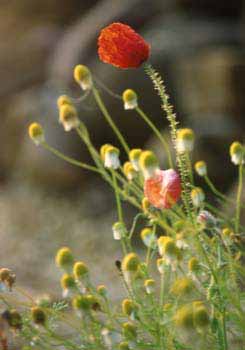
11 Corn Poppy
12 Chamomile
13 Chrysanthemum
These beautiful but short-lived flowers may have been the ones Isaiah (40:6.8) had in mind when he used "the flowers of the field" as symbol of human transience.
 14 Madonna Lily
14 Madonna Lily
The poet of the Song of Songs (2:1-2) sings about his beloved one: "My love, among the young women you are like a lily among thorns."
15 Mandrake
The plum-sized yellowish fruits of the mandrake have the reputation of being an aphrodisiac.
The translation is not quite clear, but these may have been the fruits that Reuben gave to his mother Leah (Gen. 30:14-15). Leah's sister Rachel then persuaded her to give them to her in exchange for a night with their husband Jacob.
They are also mentioned in the Song of Songs (7:14).
16 Nettle
This all-too-familiar plant was as common during biblical times as it is today.
In several instances it is used as a symbol of destruction: The children of Ammon shall be "a possession of nettles" (Zeph. 2:9). Isaiah (34:13) proclaims the judgement over Edom: "Thorns will overrun her citadels, nettles and brambles her strongholds."
17 Hemlock
It is not quite clear if the biblical word for poison x(Deuteronomy 32:32-33; Lamentations 3:19-20) is just a general term or if it means a particular plant.
If so, it may have been poison hemlock, same as the one used in Greece for the cup of poison given to Socrates.
PLANTS OF TRADE
18 Aloe
Aloe was popular for many reasons, for pharmaceutical purposes as well as for embalming.
The King's robes are described as being "fragrant with myrrh and aloes and cassia" (Ps. 45:8),
After Jesus was dead, "Nicodemus brought a mixture of myrrh and aloes, about seventy-five pounds." Together with Joseph of Arimathea, he wrapped Jesus' body "with the spices, in strips of linen." (John 19:39-40).
19 Myrrh
Myrrh is the most precious of resins known in the Bible. It is used in oils, for cosmetics, and therapeutics.
It was one of the gifts of the Magi for the newborn King (Matthew 2:11).
20 Cistus/Rock Rose
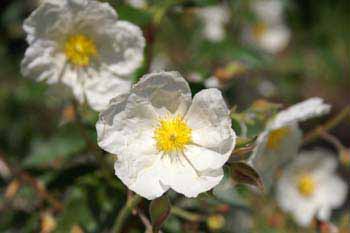 Several species of cistus produce a resin that can be harvested by a kind of comb made from leather straps.
Several species of cistus produce a resin that can be harvested by a kind of comb made from leather straps.
In some Mediterranean regions, the farmers used to comb the resin out of the beards of the goats when they returned from their pasture.
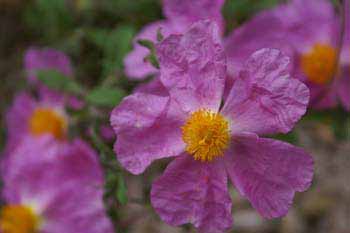
Josephs brothers sold him to a caravan carrying resin to Egypt. (Gen. 37:25).
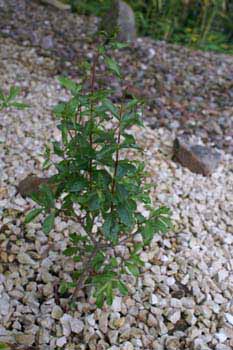 21 Henna
21 Henna
Very likely, henna was already cultivated and used as a dye during biblical times.
The poetess of the Song of Songs compares her lover to a "cluster of henna blossoms from the vineyards of En Gedi" (1:14).
22 Common Madder
The roots of this plant are used to make a red dye.
The plant itself is not mentioned explicitly in the Bible, but the Hebrew term can be identified in the root of several proper names (like "Puah", Judges 10:1) so that we can assume the plant was well-known.
23 Carob tree
The sweet pulp from the pods of the carob tree can be used to make syrup.
It is native to Israel, yet it is not quite clear if the Bible mentions it. The pods may have been used as pig food, tempting the Prodigal Son in Jesus' Parable (Luke 15:16) to fill his empty stomach.
24 Calabash
Only the name of a town ("Dilean", Joshua 15:37-38) hints at the existence of this plant which is native from Africa.
The dried fruit was used as a bottle for liquids.
25 Palmarosa Grass
26 Lemon Grass
Rub the leaves of one of these grasses, and you will instantly notice the fragrance of the essential oils they contain. These oils were used for producing perfume during biblical times Exodus 30:23; Ez. 27:19-21).
27 Flax
Flax was cultivated during biblical times, and its fibers were spun into fabric. After his death, Jesus' body was wrapped in linen cloths (Joh. 19,40 ).
28 Cotton
Cotton was probably not known until late Old Testament times.
Fine cotton cloths were part of the King's splendor in the book of Esther (1:5-6).
29 Pine Tree
The Hebrew term used in Isaiah 44:14 used to be translated as "oak", but most likely it means the pine tree, an umbrella-shaped coniferous tree growing to a height of up to 100 ft. The cones contain edible seeds.
30 Cypress
The cypress is one of several coniferous trees whose wood was used to build houses and boats (1. Kings 9:11; Ez. 27:3-5)
31 Castor Oil Plant
The oil of the castor plant has long been used for lamps and for pharmaceutical purposes.
While the prophet Jonah was waiting for God to destroy the town of Nineveh, God made a plant grow for him that may have been the fast-growing castor plant. The plant gave Jonah shade for only one day, however, since God sent a worm to make it wither the very next night (Jona 4:6-7).
32 Apple Tree
It is not quite clear if apples are mentioned in the Bible. Most translations have them in the Song of Songs (2:5): "Refresh me with apples, for I am faint with love."
Contrary to popular belief, the fruit in the Garden of Eden is not expicitly stated to be an apple.
33 Mulberry Tree
The fruits of the mulberry tree resemble blackberries and can be eaten fresh or dried like raisins. The leaves of the tree were used to cultivate silkworms on.
The prophet Amos emphasizes that his profession is not originally being a prophet but rather raising and taking care of mulberry trees (Amos 7:14). The tax collector Zacchaeus climbed a mulberry tree in order to be able to see Jesus coming (Luke 19:4).
34 Date Palm
Native to the oases, the date palm is an important source of nutrition for desert inhabitants. Jericho is called the "City of Palms" in the Bible.
When Jesus came into Jerusalem riding on a donkey, the people took palm branches and came to greet him ( John 12:12-13).
AQUATIC PLANTS
35 Common Reed
The common reed, a plant of the bogs and marshes, was used as a material for fences, mats, pens, and many other items of daily life. In the Bible it is a symbol of fragility and swaying (1 Kings 14:15; 2 Kings 18:21).
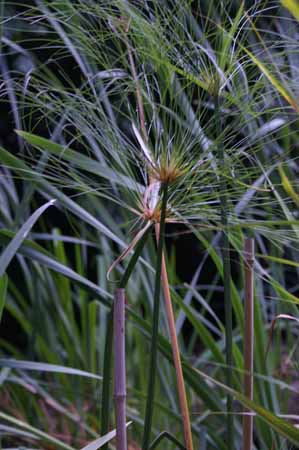 36 Bulrush
36 Bulrush
The rush, growing in ponds and swamps, is also used in a figurative sense: Isaiah emphasizes that God does not want anyone to fast ostentatiously with their heads "bowed down as a bulrush" (Isaiah 58:5).
37 Cattail
The biblical word used in Exodus 2:3-5 probably is a generic term for several species of aquatic plants. But as cattail is commonly found in the channels and Nile tributaries, this probably was the plant that the basket with the baby Moses was hidden in by his mother.
38 Papyrus Sedge
The triangular stem of the papyrus plant has long been used in ancient Egypt for everyday items like boxes, mats, ropes, boats, shoes, huts, clothing, and paper.
Very likely Moses' mother would have used this plant to weave a basket for her baby boy (Exodus 2:3).
AGRICULTURE
39 Wild Mint
40 Dill
41 Cumin
Giving a tenth of your earnings (tithe), even down to small things like spices - mint, dill and cumin - is a good thing, Jesus says, but make sure you don't neglect the more important things God expects of us: justice, mercy and faithfulness (Matthew 23:23).
42 Nigella Sativa
Nigella sativa goes by many different names in the English language: caraway, fennel flower, black onion seed, to name only a few. It has been grown as a spice for a long time. In Mediterranean countries, the seeds are even nowadays used to flavor bread.
Isaiah (28:27) gives a good practical explanation of how it is to be treated after harvesting.
43 Durum Wheat
Durum wheat was the most important grain during biblical times, constantly endangered by drought ((Dt. 8:8)). Egypt with its irrigated fields must have appeared like a wonderful granary.
Jesus tells a story of weeds growing up with the wheat (Matthew 13:24-30).
44 Barley
Barley was considered to be inferior to wheat, as the "poor man's bread".
When all those people listening to Jesus got hungry, the disciples found a boy who had five barley loaves and two fish (John 6:8-9)
45 Proso Millet
46 Sorghum
During post-biblical times millet and sorghum, two related kinds of cereal, were popular.
The prophet Ezechiel is told to bake a supply of bread for himself from wheat, barley, beans, lentils, and millet (Ez. 4:9).
47 Lentil
Lentils have long been a popular food staple.
Esau sold his birthright to his brother Jacob for a pot of lentil stew (Genesis 25:34).
48 Fava Bean
Beans were an important nutrient too (2 Sam. 17:27-29). They were either ground to make flour for a coarse kind of bread or to make soup.
49 Leek
50 Onion
51 Garlic
In the desert, the people of Israel remembered and longed for the delicious fish and vegetables they had had in Egypt (Num. 11:5-6).
Strangely enough, these vegetables, though obviously well-known, are not mentioned anywhere else in the Bible.
52 Water Melon
The water melon, native to Africa, has long been known in Egypt.
The people of Israel seem to have enjoyed this fruit in Egypt and yearn for it in the desert (Num. 11:5-6)
53 Melon
The "Daughter of Zion" is left like "a lodge in a garden of cucumbers" (Isaiah 1:8), according to older translations like KJV or Luther. Melons were unknown in Northern Europe at the time these translations were written - as cucumbers were during biblical times.
Plain huts made of branches or rocks were used to guard the melon fields.
54 Arugula
Bedouins like to gather and use arugula as a salad.
One of the prophets of the group around Elisha goes out into the fields to gather wild herbs like arugula and accidentally returns with poisonous colocynths instead (2 Kings 4:39).
PLANTS OF THE DESERT
55 Coriander
"Man hu?", "What is this?" the people of Israel asked when they found something edible in the desert (Ex. 16:31). The "Manna", as they consequently called it, resembled the seeds of coriander, a weed or herb native to Israel.
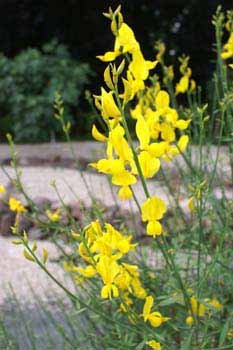 56 White Broom / Spanish Broom
56 White Broom / Spanish Broom
In the scarce shade supplied by the thin twigs of the white broom tree or bush Elijah sat on his flight from Queen Jezebel and wished he was dead (1 Kings 19:4).
In our Biblical Garden we do not have the white broom, but a beautifully flowering yellow species.
57 Caper
The translation is not quite clear, but most likely Eccl. 12:5 uses the caper as a symbol of human mortality.
The buds of the flowers can be pickled and eaten.
58 Common Myrtle
The myrtle is not a plant of the desert, but an evergreen bush that can grow as high as six feet. Its twigs have early been used for festive occasions.
Isaiah (41:19) prophesies that God will make myrtles and other water-loving green plants grow in the desert.
PLANTS OF ESCHATOLOGY
59 Syrian Oregano/ Hyssop
There is some confusion about which plant is meant in Ex. 12:21-22 where Moses tells the elders of Israel to take a bunch of hyssop, dip it into the blood of the Passover lamb, and put the blood on the door frame, the problem being that the common hyssop probably was unknown in that region. Therefore, most likely the Syrian oregano was used for this purpose. This plant still is popular today for making tea or as a spice.
On the other hand, it is difficult to imagine a sponge being stuck onto the soft stems of the oregano (John 19:29).
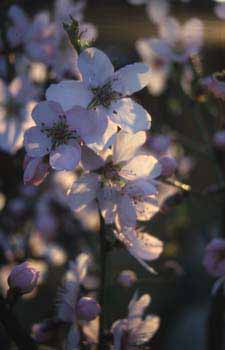 60 Almond Tree
60 Almond Tree
The almond tree is the first tree to announce the upcoming spring with its bloom.
For this reason, almond and fig trees were considered symbols of the upcoming end of the world. (Eccl 12:5; Mk 13:25).
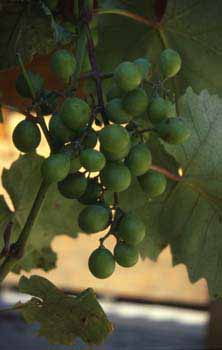 61 Grape
61 Grape
Grapes were one of the earliest plants to be cultivated.
Even in pre-israelite times people had a good knowledge of viticulture: The spies Moses sent in order to explore the land of Canaan returned with a gigantic grape that took two people to carry (Num. 13:24).
God has made the "wine that gladdens the heart of man" (Psalm 104:15).
And in the New Testament the vines of the grape become a symbol of Jesus Christ who says: "I am the vine, you are the branches" (John 15:5)
References:
• Michael Zohary: Plants of the Bible, New York: Cambridge University Press, 1982
• F. Nigel Hepper: Planting a Bible Garden, 1998
Blessed is the one who does not walk in the counsel of the wicked
or stand in the way of sinners
or sit in the seat of mockers.
But his delight is in the law of the LORD,
and on his law he meditates day and night.
He is like a tree planted by streams of water,
which yields its fruit in season
and whose leaf does not wither.
Whatever he does prospers.